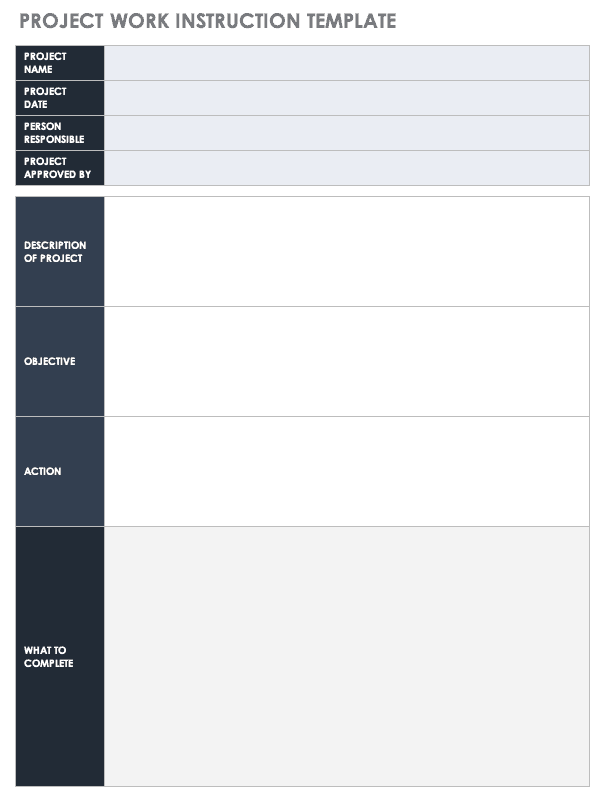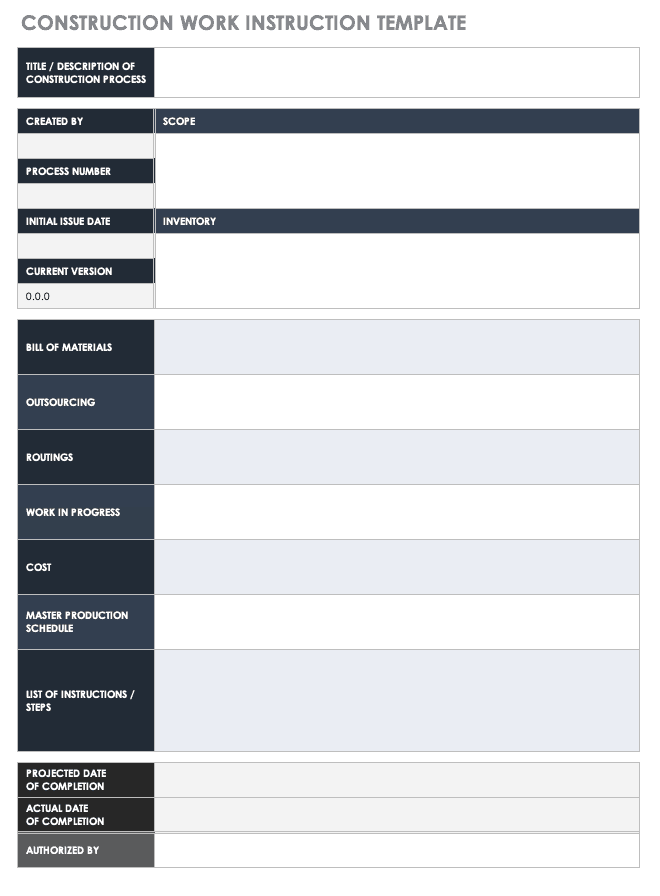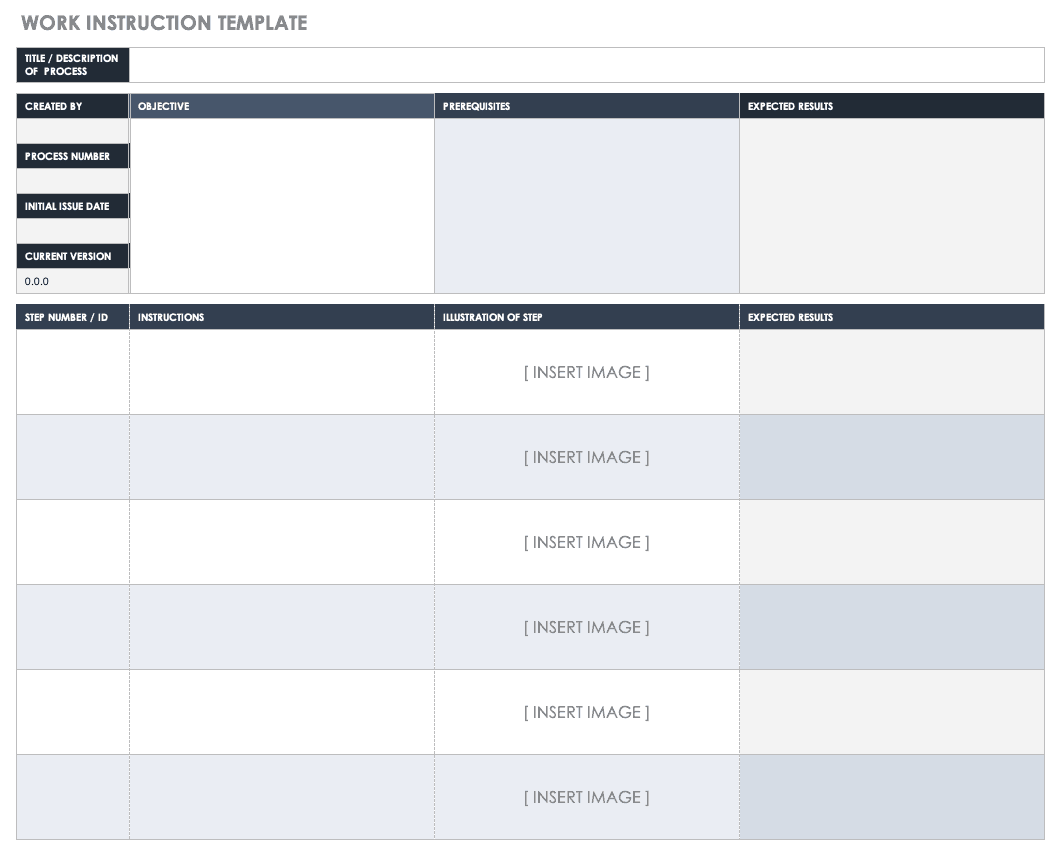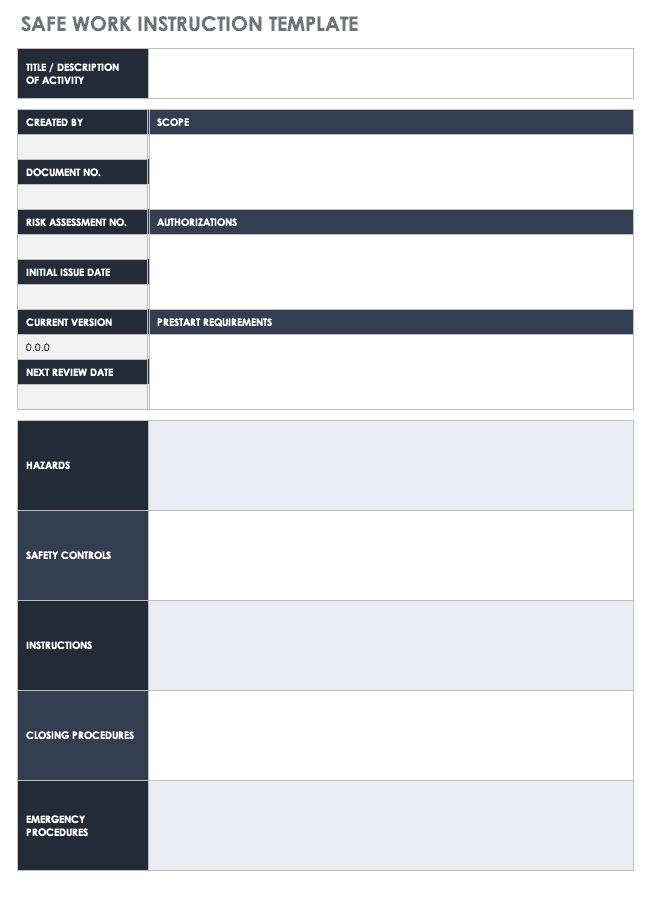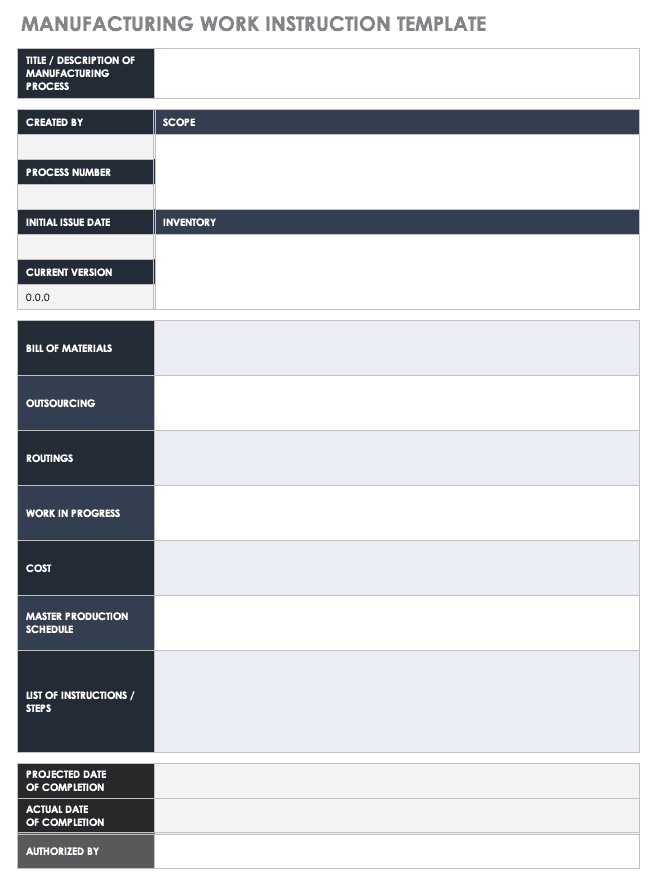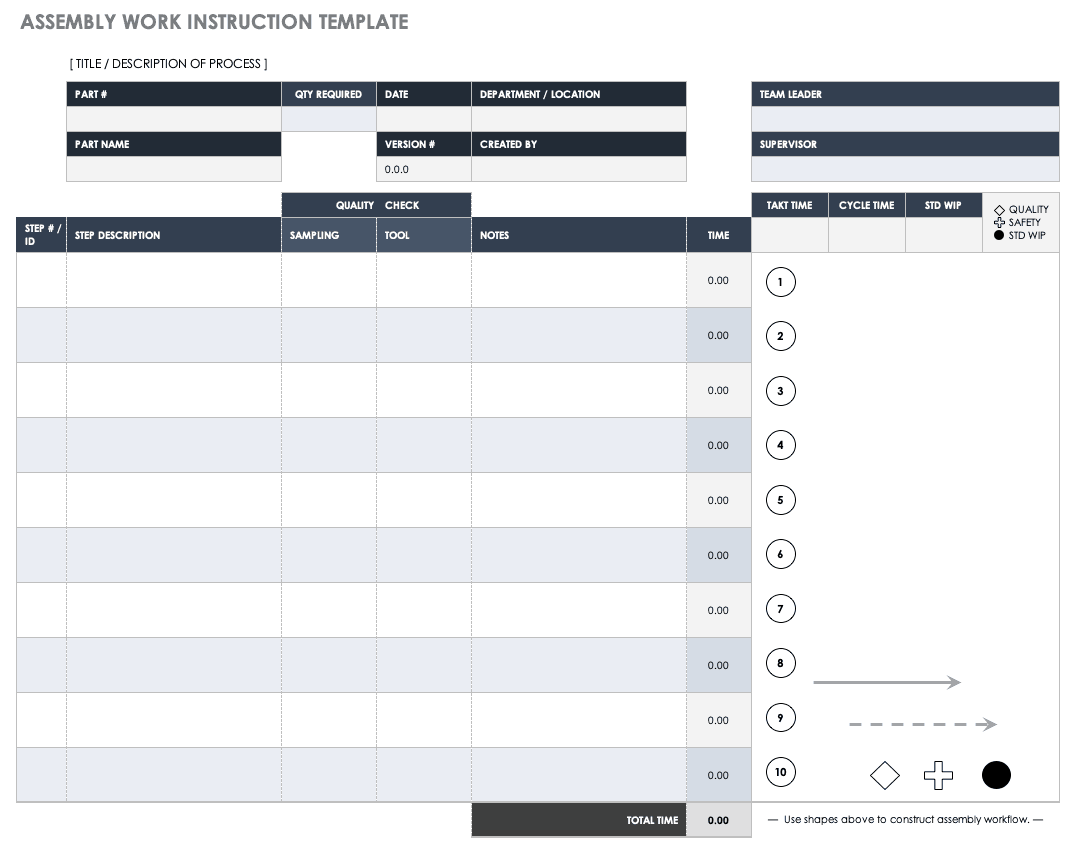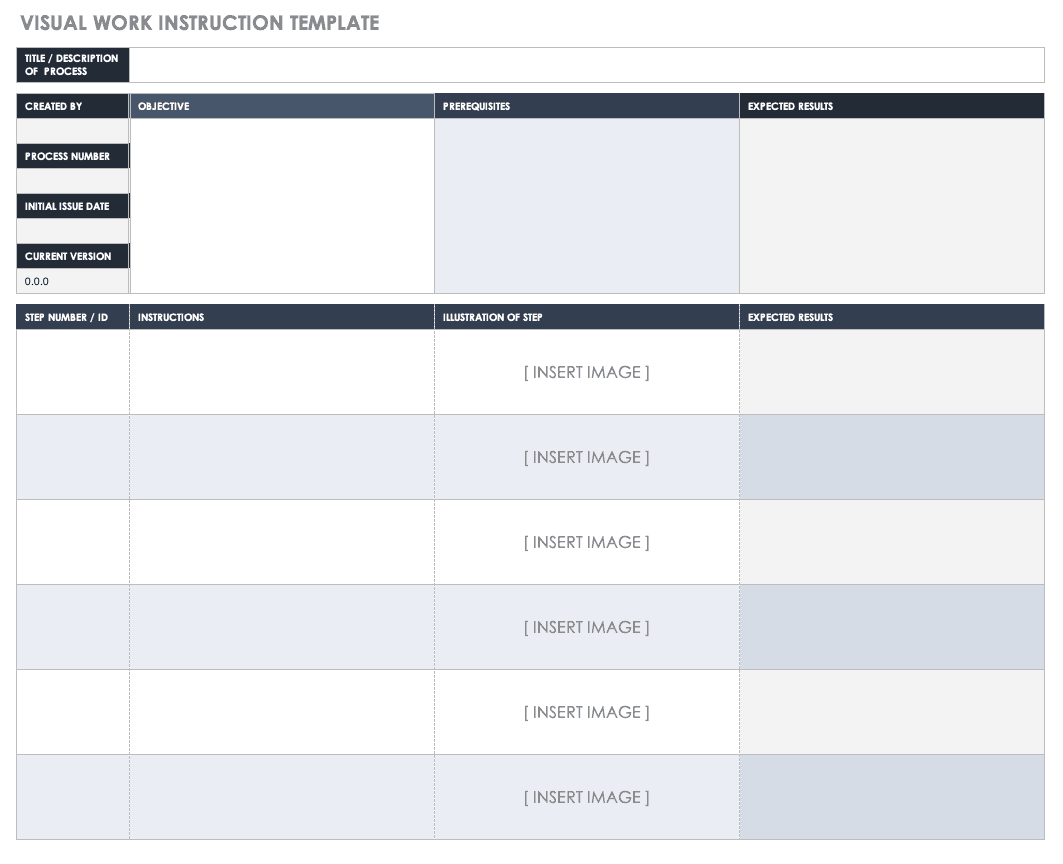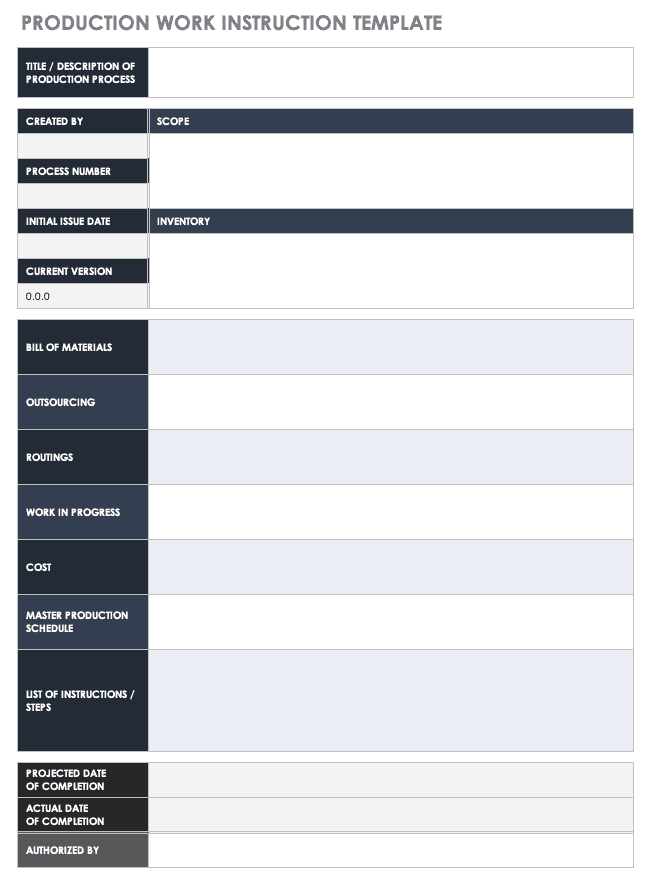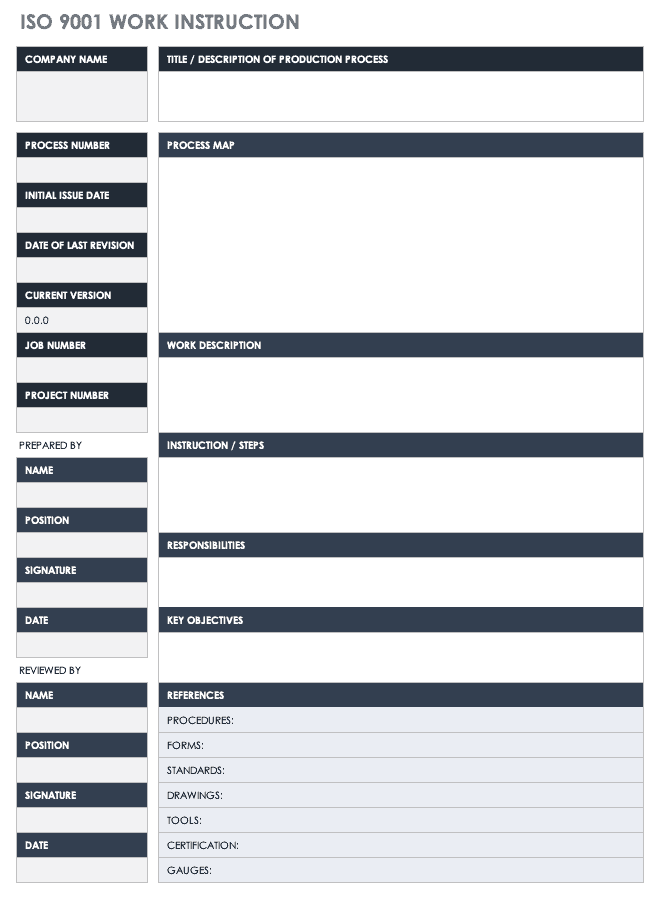Project Work Instruction Template
Use this template to explain the process involved for both general and industry-specific work projects. It includes space to document objectives, actions, and tasks, along with names and descriptions of sequential tasks. This template is designed to give you the freedom to provide instruction on a variety of projects, but is targeted enough to provide structure and improve business communication.
Download Project Work Instruction Template
Excel | Word | PDF | Smartsheet
Construction Work Instruction Template
This template is geared toward writing comprehensive, logical instructions for a construction project or process. With space to document individual steps, projected and actual date of completion, master production schedule, and authorizations, this template tracks all of the details needed to complete a specific construction process.
Download Construction Work Instruction Template
Excel | Word | PDF | Smartsheet
Work Instruction Template
This template is designed to document a basic work process with thorough instructions and detailed steps. Use this template to outline the instructions for a variety of work processes — it includes space to list the title of the job, the person(s) responsible for the job, the numbered steps and lists, and the expected results. This basic, customizable template will help streamline communication across teams to ensure consistency and transparency.
Download Work Instruction Template
Safety Work Instruction Template
This template provides instruction for work processes that involve strict safety policies and procedures. Use this template to document key components in safety work processes, like hazards, safety controls, requirements, and closing procedures. This step-by-step instructional guide will ensure that anyone who follows this template will meet all safety requirements.
Download Safety Work Instruction Template
Manufacturing Work Instruction Template
This template is ideal for manufacturing projects, as it helps to lay out the framework and instructions for a process. With this template, you can provide detailed directions on each manufacturing procedure, like process number or ID, due date, scope, costs, master schedules, and projected completion dates. This easy-to-edit template will help eliminate confusion by outlining individual manufacturing jobs and all of their accompanying details.
Download Manufacturing Work Instruction Template
Assembly Work Instruction Template
Use this template to document every last detail of an assembly process, from step number and quality checks to estimated time for completion and additional notes. Leverage this template to streamline each assembly work process, document any changes in the instructions, and track progress of multiple projects, as is typical in an assembly setting.
Download Assembly Work Instruction Template
Engineering Work Instruction Template
This template is designed for engineering projects and the instructions specific to those processes. Use this template to provide step-by-step instructions for individual engineering activities, with space to document project title and description, version number, project scope, project schedule, and date of completion. Manage all of your engineering projects with this instruction template, streamlining communication and ensuring that you follow all processes correctly.
Download Engineering Work Instruction Template
Visual Work Instruction Template
This is a visual version of a simple work instruction template, which offers both step-by-step instructions of a work process and crucial images that help explain each stage of a process. Use this template for intricate, detailed processes that require more explanation than written instructions can provide.
Download Visual Work Instruction Template
Production Work Instruction Template
This template provides detailed instruction on how to carry out activities in the production process, including step-by-step instructions. You’ll find areas within the template to document process updates, issue dates, cost, schedule, and authorization from upper management.
Download Production Work Instruction Template
ISO 9001 Work Instruction Template
This template provides detailed instructions for completing projects that comply with the 9001 and related quality management standards. This template includes comprehensive details that outline and describe the instructions involved in a 9001-compliant process. It also includes space to document process maps, descriptions, responsibilities, key objectives, and more.
Download ISO 9001 Work Instruction Template
What Is the Purpose of a Work Instruction Template?
A work instruction, also known as a job instruction, an operations instruction, or a visual work instruction, is vital to your business process because it presents specific, sequential, and detailed information on how to perform a certain task. It provides simple instructions not only on projects and processes, but also on a plethora of policies and procedures in such areas as security, human resources, and engineering systems.
A work instruction reduces the potential for risk or errors when executing a process, therefore boosting business efficiency and increasing accuracy. By breaking down the complex procedures and workflows of a process into detailed step-by-step instructions, the work instruction streamlines work processes, increases communication and decision making, and illuminates the job for anyone who follows the document.
Additionally, a work instruction provides many more benefits to your company when it is applied. A work instruction can help you do the following:
-
Document the correct way to perform all activities, from high-level to low-level
-
Ensure that all parties abide by standards, regulations, and operation policies
-
Provide necessary content so users don’t need to seek out explanatory information on their own
-
Maintain accurate and precise information across all departments
-
Describe how to perform specific tasks within a larger process, with more detail and greater clarity
-
Aid in training new employees or reminding current employees of processes
-
Define all parts of a process or task, such as responsibilities, requirements, tools, and other important information
-
Establish a consistent method for all processes, from IT to HR to engineering
-
Track purchases and describe all of their key components, such as quantity, unit price, and shipping dates
-
Gain approval on the purchase of an item or a change in a system process
How to Write a Work Instruction
Writing a comprehensive, clear, and educational work instruction can be a daunting task because it requires thorough attention to detail and immense knowledge about the given task or process. To take the guesswork out of writing a work instruction, follow these easy-to-follow steps:
-
Write the intro. Give context to the project, identify owners of the project, and clearly document the task or job at hand. Include a brief overview regarding the purpose of the job that’s described in the instructions.
-
Describe how to do the job. Break down each step into smaller, easy-to-follow directions to ensure that every action is clear and understandable for whomever reads it. Include all components needed to complete the job, such as materials, references, and images or visuals that support the written steps.
-
Validate information. Consult subject matter experts (SMEs) and key stakeholders to make sure that each step within the instructions is accurate and current.
-
Format for easy reading. Once all of the steps are written, ensure that the instructions are user-friendly. Check that the instructions are sequential, steps are bolded to stand out, and the instructions include numbered or bulleted lists for each step.
-
Simplify and rewrite, if necessary. Reread the document and make sure everything makes sense. Simplify the steps if there is confusion, and rewrite or reword steps when necessary to ensure consistency.
-
Test it out. Give the document to a coworker or colleague and have them follow the steps. Determine if there is any confusion, or if the instructions are unclear or lead to the wrong end goal.
-
Save and share. After you complete all of the steps above, save the document, send it out to your teams, and store it where anyone who may need the instructions can access it.
How to Create a Visual Work Instruction
A visual work instruction offers the same capabilities as a basic work instruction template, but it also provides an easier way to view the instructions described in the document. Visual work instructions are typically used in departments and fields that require a more graphical explanation of a task, such as engineering, product development, and production.
To write a visual work instruction, simply follow the same steps as you would for a regular work instruction, but add graphics, images, diagrams, or flowcharts where applicable. Document the steps in a written form, then show the same steps through visual components.
For example, let’s say you are writing about how to set up a desk for a new employee. Write down each consecutive step: locating the area where the new desk would go, assembling the legs, placing the counter of the desk on top of the legs, etc. Then take pictures of someone completing each step, or include diagrams that show exactly how each step should be performed. Remember, a work instruction focuses on providing the how behind each step of a process, so document and transcribe a process as such.
Tips for Writing Your Work Instructions
To help you put together the best, most comprehensive work instruction for all of your business processes, refer to these helpful tips as you write, edit, and maintain your work instruction.
-
Make sure the meaning is clear and easy to understand for every employee, team member, or stakeholder who references it.
-
Gather all necessary information beforehand to get an idea of how you want to structure your instructions, and write the process by consulting with people who are knowledgeable of the task or job.
-
Determine all high-level procedures, policies, and dependencies that govern the task or job for which you are creating instructions.
-
Avoid complex words and sentences, unnecessary jargon, acronyms, and technical terms, while also keeping the language consistent.
-
Use the active voice so the person reading the instructions can relate to them.
-
Keep the document as short and concise as possible, make sure all data and information is helpful and accurate, and organize all steps logically.
-
Include visuals or images when appropriate to make the document engaging, and to complement the written portions of the instructions.
-
Ensure that the final document is easily accessible.
-
Review the document on a regular basis, and update the instructions as needed.
The Difference between a Work Instruction and a Standard Operating Procedure
Work instructions and standard operating procedures (SOPs), also known as job aids and user manuals, are important tools leveraged in a workplace, as they both help to describe a process in detail and provide instruction on the best way to carry out a procedure. Both are considered more detailed than a procedure and provide instruction on the specifics of a work process. However, they differ in terms of what exactly they describe.
Simply put, SOPs help describe what should be done, by whom, and in what time frame. SOPs describe everything that you should do in a certain situation or as you carry out a certain work process.
Conversely, a work instruction describes how a process should be completed, documenting how each individual step should be performed in an effort to streamline the overall operation. Work instructions support each of the procedures that are outlined by an SOP, and usually, there is a work instruction that complements every SOP or procedure.
Why Is a Work Instruction Important?
Organizations can often overlook work instructions because processes seem simple to understand, there are already people trained to help others learn the processes, or businesses simply don’t want to spend the time creating detailed instructions for each process. That said, a work instruction is vital to a company’s success, for many reasons.
A work instruction helps to both build the company’s knowledge base and to preserve it through documented instructions. Work instructions help to avoid any wrong and misguided interpretations of a process, override human error, reduce the “blame game” when a process goes wrong, and ensure utmost safety while performing a task. In the long run, a work instruction can also save time for a business by establishing and documenting the most efficient way of completing a process.
All in all, the investment in time to create a work instruction for a process will be paid back once it has been circulated throughout the company and used by many employees.
Work Instruction Resources
As you put together your own document, refer to these resources to gain further information on how to write a work instruction, why a work instruction is important, and how a well-written work instruction can positively impact your business. Additionally, reference samples in order to create the most comprehensive work instruction for your business needs.
Improve Work Instruction with Real-Time Work Management in Smartsheet
Empower your people to go above and beyond with a flexible platform designed to match the needs of your team — and adapt as those needs change.
The Smartsheet platform makes it easy to plan, capture, manage, and report on work from anywhere, helping your team be more effective and get more done. Report on key metrics and get real-time visibility into work as it happens with roll-up reports, dashboards, and automated workflows built to keep your team connected and informed.
When teams have clarity into the work getting done, there’s no telling how much more they can accomplish in the same amount of time. Try Smartsheet for free, today.
